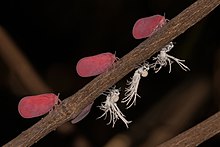A planthopper is any insect in the infraorder Fulgoromorpha,[1] in the suborder Auchenorrhyncha,[2] a group exceeding 12,500 described species worldwide. The name comes from their remarkable resemblance to leaves and other plants of their environment and that they often "hop" for quick transportation in a similar way to that of grasshoppers. However, planthoppers generally walk very slowly. Distributed worldwide, all members of this group are plant-feeders, though few are considered pests. The infraorder contains 2 superfamily, Fulgoroidea and Delphacoidea. Fulgoroids are most reliably distinguished from the other Auchenorrhyncha by two features; the bifurcate (Y-shaped) anal vein in the forewing, and the thickened, three-segmented antennae, with a generally round or egg-shaped second segment (pedicel) that bears a fine filamentous arista.
| Planthopper Temporal range: | |
|---|---|
 | |
| Flatida rosea (Flatidae) adults and nymphs | |
| Scientific classification | |
| Domain: | Eukaryota |
| Kingdom: | Animalia |
| Phylum: | Arthropoda |
| Class: | Insecta |
| Order: | Hemiptera |
| Suborder: | Auchenorrhyncha |
| Infraorder: | Fulgoromorpha Evans, 1946 |
| Families | |
Overview
Planthoppers are laterally flattened and hold their broad wings vertically, in a tent-like fashion, concealing the sides of the body and part of the legs.[3] Nymphs of many fulgoroids produce wax from special glands on the abdominal terga and other parts of the body. These are hydrophobic and help conceal the insects. Adult females of many families also produce wax which may be used to protect eggs.[4]

Fulgoroid nymphs also possess a biological gear mechanism at the base of the hind legs, which keeps the legs in synchrony when the insects jump. The gears, not present in the adults, were known for decades[5] before the recent description of their function.[6]
Planthoppers are often vectors for plant diseases, especially phytoplasmas which live in the phloem of plants and can be transmitted by planthoppers when feeding.[7]
A number of extinct members of Fulgoroidea are known from the fossil record, such as the Lutetian-age Emiliana from the Green River Formation (Eocene) in Colorado.[8]
Both planthopper adults and nymphs feed by sucking sap from plants; in so doing, the nymphs produce copious quantities of honeydew, on which sooty mould often grows.[3] One species considered to be a pest is Haplaxius crudus, which is a vector for lethal yellowing, a palm disease that nearly killed off the Jamaican Tall coconut variety.[9]
Classification
As mentioned under Auchenorrhyncha, some authors use the name Archaeorrhyncha as a replacement for the Fulgoromorpha.
The extant families of Fulgoroidea are:[4]
- Acanaloniidae
- Achilidae
- Achilixiidae
- Caliscelidae
- Derbidae
- Dictyopharidae
- Eurybrachidae (= Eurybrachyidae)
- Flatidae
- Fulgoridae
- Gengidae
- Hypochthonellidae
- Issidae (sometimes includes Caliscelidae)
- Kinnaridae
- Lophopidae
- Meenoplidae
- Nogodinidae
- Ricaniidae
- Tettigometridae
- Tropiduchidae
And the Delphacidea contains the following extant families:
Extinct families include:
- †Dorytocidae Emeljanov and Shcherbakov 2018, monotypic, Burmese amber, Cenomanian
- †Fulgoridiidae Handlirsch 1939 Early-Upper Jurassic, Eurasia
- †Jubisentidae Zhang et al. 2019 Burmese amber, Cenomanian
- †Katlasidae Luo et al. 2020, monotypic, Burmese amber, Cenomanian
- †Lalacidae Hamilton 1990 Crato Formation, Brazil Lushangfen Formation, Yixian Formation, China, Aptian
- †Mimarachnidae Shcherbakov 2007 Early Cretaceous- early Late Cretaceous, Eurasia
- †Neazoniidae Szwedo 2007 Lebanese amber, Barremian, Charentese amber, France, Cenomanian
- †Perforissidae Shcherbakov 2007 Early Cretaceous- early Late Cretaceous, Argentina, Lebanon, Mongolia, Myanmar, Russia, Spain, New Jersey
- †Qiyangiricaniidae Szwedo et al. 2011 monotypic, Guanyintan Formation, China, Toarcian
- †Weiwoboidae Lin et al. 2010 monotypic, Yunnan, China, Eocene
- †Szeiiniidae Zhang et al. 2021 monotypic, Shaanxi, China, Late Triassic
- †Yetkhatidae Song et al. 2019 Burmese amber, Cenomanian
Gallery
- Flatolystra verrucosa (Fulgoridae)
- nymphal Dictyophara europaea (Dictyopharidae)
- Paropioxys jucundus (Eurybrachidae)
- Bruchomorpha decorata (Caliscelidae)
- Green coneheaded planthoppers, Acanalonia conica in the infraorder Fulgoromorpha, on the underside of a milkweed leaf
Notes
References
- Wilson, Stephen W. (2005). "Keys To The Families Of Fulgoromorpha with emphasis on planthoppers of potential economic importance in the southeastern United States (Hemiptera: Auchenorrhyncha)" (PDF). Florida Entomologist. 88 (4): 4. doi:10.1653/0015-4040(2005)88[464:KTTFOF]2.0.CO;2. Archived from the original (PDF) on 2010-12-06.
- Bourgoin T. 1996-2015. FLOW (Fulgoromorpha Lists on The Web): a world knowledge base dedicated to Fulgoromorpha. https://web.archive.org/web/20140111091457/http://www.hemiptera-databases.org/flow/
- Larivière, M.-C.; Fletcher, M.J.; Larochelle, A. 2010: Auchenorrhyncha (Insecta: Hemiptera): catalogue.Fauna of New Zealand, (63)
- Swzedo J.; Bourgoin T.; Lefèbvre, F. 2004: An annotated catalogue of Fulgoromorpha, :37–137. In: Fossil Planthoppers (Hemiptera: Fulgoromorpha) of the world. An annotated catalogue with notes on Hemiptera classification. Swzedo, J., Th. Bourgoin & F. Lefèbvre. J. Swzedo edt., Warsaw 2004, 199 pp + 8 pl.
External links


- Metcalfa pruinosa, citrus flatid planthopper on the University of Florida/IFAS Featured Creatures website
- Ormenaria rufifascia, a flatid planthopper on the University of Florida/Institute of Food and Agricultural Sciences Featured Creatures website







